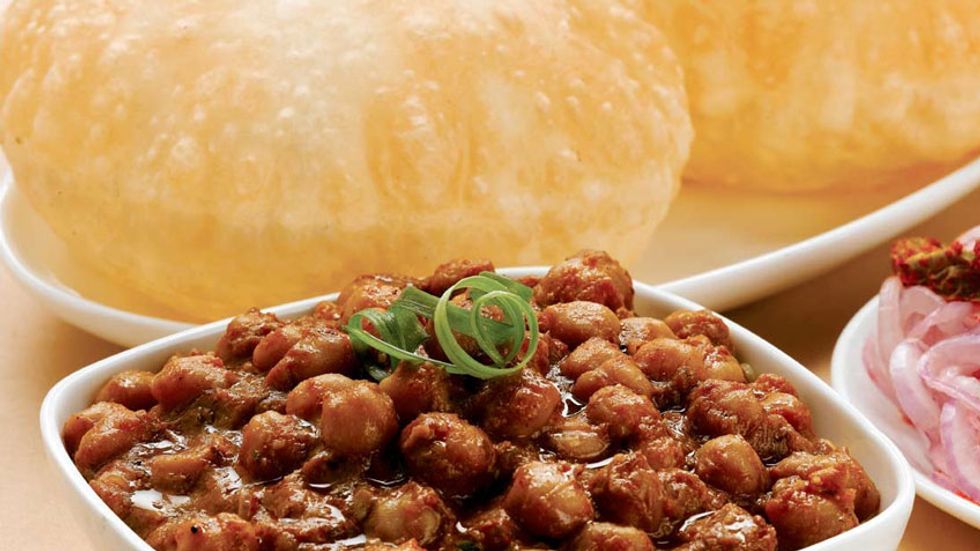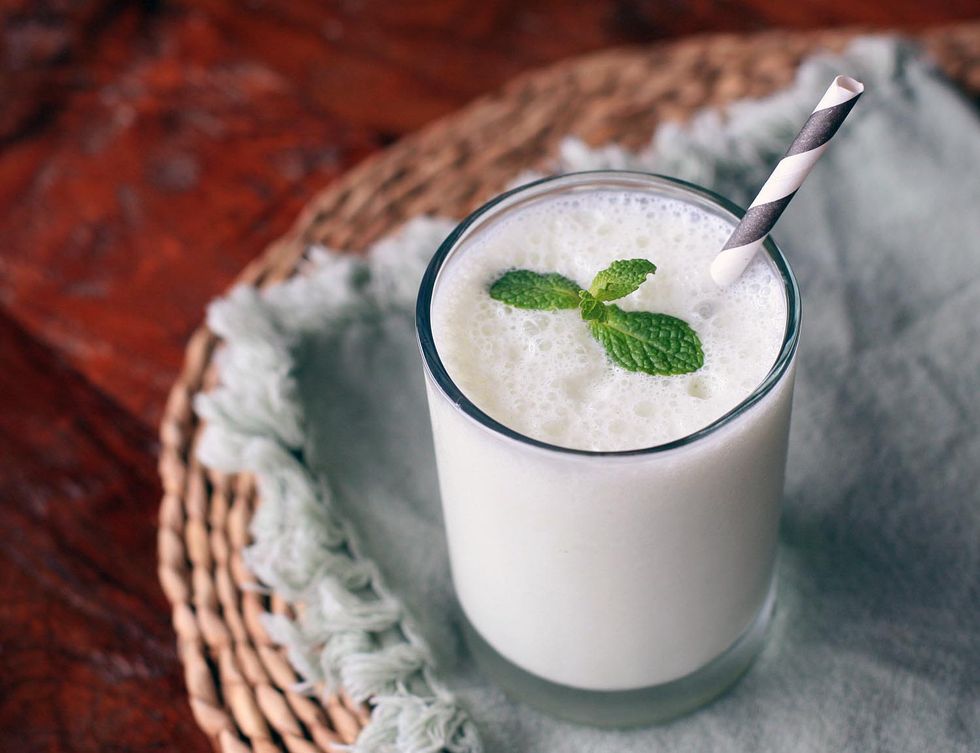You're at an Indian restaurant. Everyone's told you how good Indian food is, and you want the best experience possible. You look at the menu and you're stumped. What do you do now?
Fret not, my friend. Here are some pointers to bring the most out of your Indian meal.
1. Understand How Dishes Are Paired
Chole Bhature. Photo taken from cooktube.in
You have dry vegetable dishes, vegetable curries, dry meat dishes and meat curries. You have rice, biryani and then a whole different array of 'breads'. What goes with what?
Let's keep it simple.
Ideally, you'd want 2 dishes (vegetables or meat) with a side of carbs. This isn't a strict rule. You could go with more dishes if you'd like an eclectic spread and are able to afford it - or you could go with one if you're on a budget.
To make sure you get the best combination of carbs and curries/dishes, remember that Indian food is flavorful and you do not want to mix too many complex flavors together.
This means that if you're going to pick a vegetable or meat dish, you'd want to go with plain carbs - like plain Naan, Chapati, Paratha and so on.
Maybe for a bit extra flavor, you'd choose the garlic or butter naan.
The problem usually occurs if you choose to go with a high flavor carb - say Chicken Dum Biryani - and try to pair it with other meat and vegetable dishes.
The result will be a mix of everything, and uniquely nothing. It'll all just be a mess in your mouth. You don't want that.
If you're lured to the biryani - just stick to that! You don't need anything else.
And also be aware that certain dishes are often exclusively paired with certain breads. A key example would be Chole or Chana Masala. This spicy chickpea curry is usually paired with a Bhatura , a fried white flour bread that is usually crispy, as seen in the image above. Another example would be any type of daal. Usually, that is paired with a side of rice or chapati, rarely with Naan, and almost never with Puri or Bhatura. Of course, this is not to say that you can't try - who knows you may discover something unique to your liking!
If you're confused, don't be afraid to ask the staff or your Indian friends!
2. Stop Counting Those Calories
Photo taken from Pexels.com
Face it. If you're at an Indian restaurant - there is no way you are going to stick to your calorie count. Not only are the dishes loaded, the fact is that the food is so complex, there is no way you will be able to accurately calculate your macronutrients or calories.
If you really want to hit your macros while consuming Indian food - make Indian food at home yourself. That way you'd be able to monitor each ingredient that goes in. Also, there are tonnes of healthy Indian recipes online which warrant another article on their own!
So if you're at an Indian restaurant -
Just let the calorie counting go and enjoy the meal stress free.
3. Use Your Hands
Photo taken from Pexels.com
This is the Eastern version of the argument 'How can you not eat Pizza with your hands?'.
The fact is, Indian food, in India is always consumed directly by hand. Remember though that you must only eat with one hand. If you travel to India, eating with both hands is often considered rude or unmannerly. There are ways to break the bread with one hand, scoop up the sides and eat! You'll simply have to learn it. Take up the challenge!
The fact is that it is difficult to eat naan or any other type of 'breads' with a spoon, knife or fork. The 'bread' is meant to be used to scoop the sides. Also, in Indian culture, it is a belief that one must be connected with the food they eat. That is literally done by eating with the hands. Each finger is also associated with one of the five elements - earth, fire, water, air and space and so in eating with your hands, you are bringing all 5 of your inner elements together to improve your consciousness of the food you are eating.
Dining, in India, is a multi-sensorial experience - the sights of beautiful colors, enticing aromas, eclectic flavors and of course the texture of the variety of the foods. Don't be afraid to give in and experience all that Indian food has to offer. Immerse yourself wholly and you will truly feel way more satisfied with the meal if you are to eat by your hands.
4. Be Clear About How Much Spice You Can Handle
Photo taken from Pexels.com
The thing about Indian restaurants around the world is that you will never find consistency across restaurants with regards to how spicy they make a dish.
Trust me on this - I am an Indian who can't take spice (sacrilege I know), and I had to learn this the hard way.
The fact is, some restaurants might state that a certain dish is 'mild' - but that may be too much for you. Others may say the same dish is 'spicy' when in fact it is not.
Usually, restaurants in India will tell you that dishes aren't spicy and restaurants in the West will tell you that they are, and often the result is the opposite of what they tell you.
The reason behind this is simple. The tolerance of spice of different communities is different. So to get around this - be clear about how much you can take and specify to the waiter taking your order on the level of spice you'd like. Restaurants are happy to accommodate whenever they can!
5. Don't Be Afraid of 'Lassi'!
Lassi. Photo taken from girlcooksworld.com
You might flip to the drinks menu and read about 'Lassi'. It's a popular Indian yogurt drink that many Indians usually accompany their meals with. You might think it's too heavy. You might think yogurt is strange for a drink.
Trust me on this - order the 'Sweet Lassi'. It's a sweetened Yogurt drink that will not only fill you up and so you will be able to manage the rest of your portions, but it is also a great spice quencher!
What's more - the sweetness allows you to skip dessert. Why would you want to that you may ask?
Well because...
6. Indian Desserts Are Not What You'd Expect
Jalebi. Photo taken from mapsofindia.com
Craving something sweet after the meal? Maybe a little Ice Cream or so? Sure, get your dessert elsewhere.
Indian desserts are simply too good. When I say 'too', I really mean that. They're reaaaaallysweet. No other way to put it.
That being said - they're fantastic and you might want to consider trying sweets on a separate occasion when you're not stuffed after a huge Indian meal.
Desserts like Gulab Jamun and Jalebi are deep fried and hot and not what you'd expect from a dessert. Often a single serving will do the trick, and it will be hard to eat more than one!
Long story short - they're simply very sweet and very addictive - so be careful.
7. Don't Forget The 'Saunf & Mishri' On The Way Out!
Saunf (right) & Mishri (left). Photo taken from garlicandbutter.blogspot.com
If you are observant, after paying your bill, you'll notice at the cashier or on a counter on the way out that there are little bowls with small green seeds and little white cubes.
Wondering what that is?
We call it the green seeds 'Saunf' and the white cubes ' Mishri' . They're simply fennel seeds and rock sugar respectively.
Usually after a hearty Indian meal, one would eat a bit of Saunf and a bit of Mishri. The combination is said to not only aid digestion but also provide you with a minty and sweet after-flavor and get rid of any bad breath.
So don't forget it!
An Indian Buffet. Photo taken from AXS.com
These 7 pointers are a must to make the most of your Indian gastronomic experience. Take heed and enjoy that Chicken Tikka Masala... with your hands!













 man making a coffee lattePhoto by
man making a coffee lattePhoto by  Photo by
Photo by  Photo by
Photo by  Photo by
Photo by 









 Photo by
Photo by 








